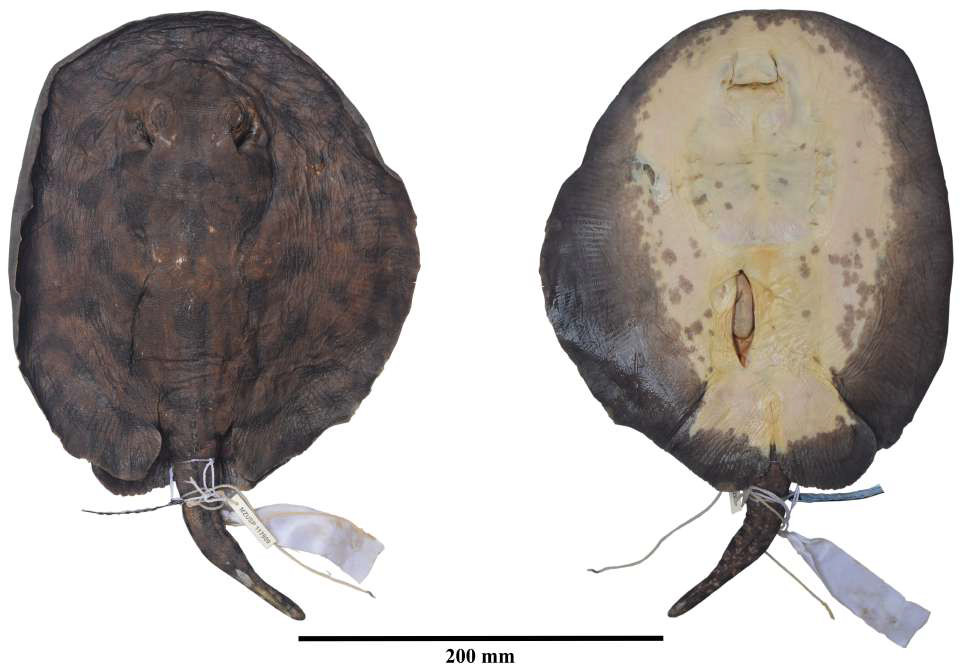Potamotrygon wallacei
De Carvalho, Rosa & De Araújo, 2016
Classification: Elasmobranchii Myliobatiformes Potamotrygonidae
Reference of the original description
A new species of Neotropical freshwater stingray (Chondrichthyes: Potamotrygonidae) from the Rio Negro, Amazonas, Brazil: the smallest species of Potamotrygon. Zootaxa, 4107(4), 566–586
A new species of Neotropical freshwater stingray (Chondrichthyes: Potamotrygonidae) from the Rio Negro, Amazonas, Brazil: the smallest species of Potamotrygon. Zootaxa, 4107(4), 566–586
Types
Potamotrygon wallacei
Holotype: MZUSP: 117809; Paratype: BMNH: 1893.4.24.42; MNRJ: 3532; MZUSP: 10290; MZUSP: 19209; MZUSP: 104962; MZUSP: 104966; MZUSP: 104977; MZUSP: 117804; MZUSP: 117805; MZUSP: 117806; MZUSP: 117807; MZUSP: 117808; MZUSP: 117810; MZUSP: 117811; MZUSP: 117812; UFPB: 3543; UFPB: 4866; UFPB: 4867; UFPB: 9017;
Potamotrygon wallacei
Holotype: MZUSP: 117809; Paratype: BMNH: 1893.4.24.42; MNRJ: 3532; MZUSP: 10290; MZUSP: 19209; MZUSP: 104962; MZUSP: 104966; MZUSP: 104977; MZUSP: 117804; MZUSP: 117805; MZUSP: 117806; MZUSP: 117807; MZUSP: 117808; MZUSP: 117810; MZUSP: 117811; MZUSP: 117812; UFPB: 3543; UFPB: 4866; UFPB: 4867; UFPB: 9017;
Description :
Citation: Potamotrygon wallacei De Carvalho, Rosa & De Araújo, 2016: In: Database of modern sharks, rays and chimaeras, www.shark-references.com, World Wide Web electronic publication, Version 01/2026
Please send your images of "Potamotrygon wallacei" to info@shark-references.com

Potamotrygon wallacei De Carvalho, Rosa & De Araújo, 2016, Holotype, MZUSP 107809, female, 253 mm DW © de Lima et al. 2023

Potamotrygon wallacei De Carvalho, Rosa & De Araújo, 2016, Holotype, MZUSP 107809, female, 253 mm DW © de Lima et al. 2023
Common names
raia cururu
raia cururu
Short Description
Original Diagnosis after DE CARVALHO, ROSA & DE ARAÚJO, 2016 [24103]: A species of Potamotrygon endemic to the Rio Negro drainage, diagnosed by its unique color pattern, composed of a light brown dorsal disc surface with blackish irregularly-shaped, few and broad vermiculations on central disc, delimiting a light brown amphora- or Ω-shaped figure or large light brown reniform blotches at disc center, with subcircular to reniform ocellated light brown spots towards disc margins, a dark-banded tail on its sides, and small size (smallest known species of Potamotrygon, maturing at 160–190 mm DW, largest examined specimen 310 mm DW). The following combination of characters further distinguishes this species from congeners: enlarged spines on dorsal midtail in one to three irregular rows, few in number, low, and not extending posteriorly to caudal stings, ending near mid length of tail; denticles on posterior mid-disc and tail base Y-shaped, with a central, anterior, bulbous cusp and usually two posterior pairs of smaller, rounded cusps; anterior angular cartilage well-developed, lacking posterior angular cartilage (both angulars present and well developed in most species of Potamotrygon, except P. tigrina, P. schroederi, P. histrix, P. schuhmacheri, P. orbignyi, P. humerosa, P. signata, and P. marinae; P. wallacei, n. sp., is easily distinguished from these species by its unique color pattern, arrangement of enlarged spines on dorsal tail, and smaller size); and clasper skeleton with a single basal segment (almost all species of potamotrygonids have two segments).
Original Diagnosis after DE CARVALHO, ROSA & DE ARAÚJO, 2016 [24103]: A species of Potamotrygon endemic to the Rio Negro drainage, diagnosed by its unique color pattern, composed of a light brown dorsal disc surface with blackish irregularly-shaped, few and broad vermiculations on central disc, delimiting a light brown amphora- or Ω-shaped figure or large light brown reniform blotches at disc center, with subcircular to reniform ocellated light brown spots towards disc margins, a dark-banded tail on its sides, and small size (smallest known species of Potamotrygon, maturing at 160–190 mm DW, largest examined specimen 310 mm DW). The following combination of characters further distinguishes this species from congeners: enlarged spines on dorsal midtail in one to three irregular rows, few in number, low, and not extending posteriorly to caudal stings, ending near mid length of tail; denticles on posterior mid-disc and tail base Y-shaped, with a central, anterior, bulbous cusp and usually two posterior pairs of smaller, rounded cusps; anterior angular cartilage well-developed, lacking posterior angular cartilage (both angulars present and well developed in most species of Potamotrygon, except P. tigrina, P. schroederi, P. histrix, P. schuhmacheri, P. orbignyi, P. humerosa, P. signata, and P. marinae; P. wallacei, n. sp., is easily distinguished from these species by its unique color pattern, arrangement of enlarged spines on dorsal tail, and smaller size); and clasper skeleton with a single basal segment (almost all species of potamotrygonids have two segments).
Distribution
endemic to the Rio Negro drainage in Amazonas, Brazil, occurring from Santa Isabel down to Rio Cuieiras in the vicinity of Manaus [24103] Source: www.gbif.org
endemic to the Rio Negro drainage in Amazonas, Brazil, occurring from Santa Isabel down to Rio Cuieiras in the vicinity of Manaus [24103] Source: www.gbif.org
Remarks
shark-references Species-ID=14571; CITES: (see: Protected Species for more details) Convention on International Trade in Endangered Speciesof Wild Fauna and Flora annex: III; Council Regulation 2017/160 annex: C
shark-references Species-ID=14571; CITES: (see: Protected Species for more details) Convention on International Trade in Endangered Speciesof Wild Fauna and Flora annex: III; Council Regulation 2017/160 annex: C

















